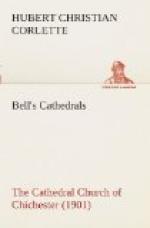Close to the ground on the south-west corner buttress are two string-courses. The lower of these is a billet-moulded course cut, like those to be seen on the south-west tower. Its presence here, and at this level, shows that this was the original level of the sills of all the old Norman windows on the outside walls until about the close of the twelfth century.
On the east side of this part of the transept, at the clerestory level, are two round-headed windows. Both originally were all of twelfth-century workmanship. But now the southern one has abaci, capitals, angle-shafts, and base, which are thirteenth-century work, and the early label-mould has been changed. The other window shows partly what was once probably the character of both of them. But the greater part of this window was restored when the central tower and spire were rebuilt after 1861. Between the windows is a buttress that was introduced when the vault was added. The south-east angle on this side retains part of the twelfth-century flat buttressing. There are on this wall and the turret different types of masonry, which represent five distinct periods of building, from the twelfth to the nineteenth century. But the junction between the work of two of these periods, being a weak part, shows by the crack down the wall from the parapet that some movement has taken place here.
Projecting eastwards from the transept is the square chapel (now a vestry), which took the place of the early apsidal one. Neither of its three windows has any tracery. The window on the south side is pointed. The arch-mould is the same as that to the round-headed window on the east; but there is a label-mould over this south one and not on the other. The abaci are new, and the angle-shafts and bases as well, but the capitals are old, though decayed. The parapet on the south is of the same character and date as that over the wall of the choir, but earlier than that above the south window of the transept, which is of the same date as that on the south wall of the nave.




